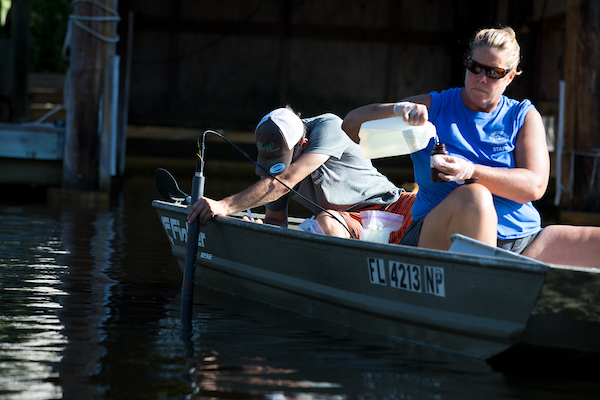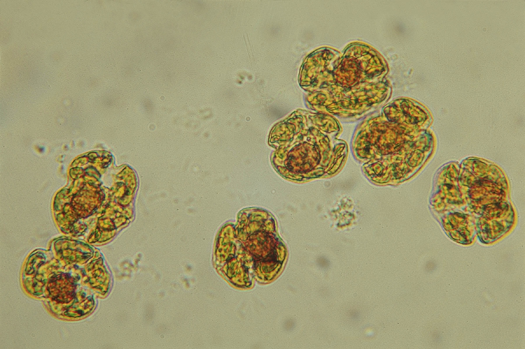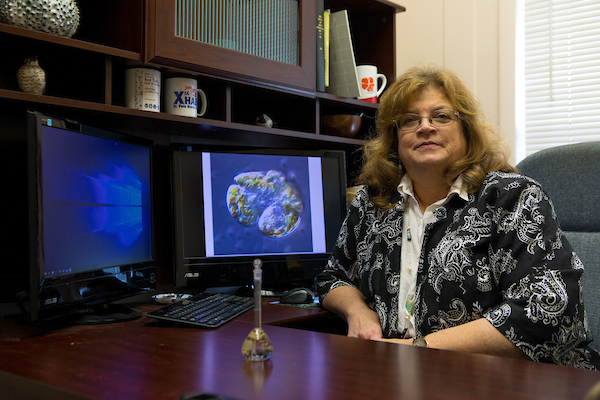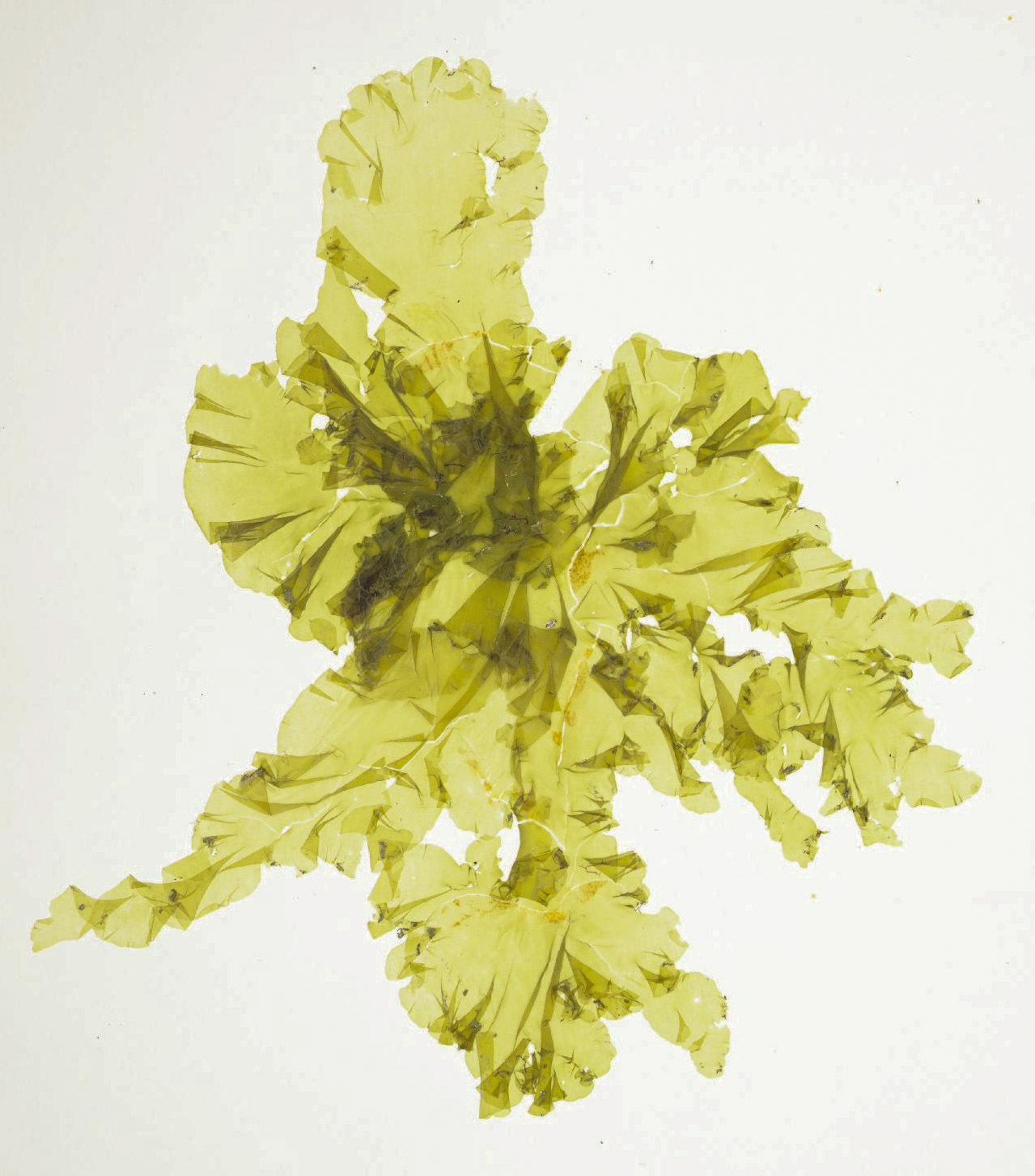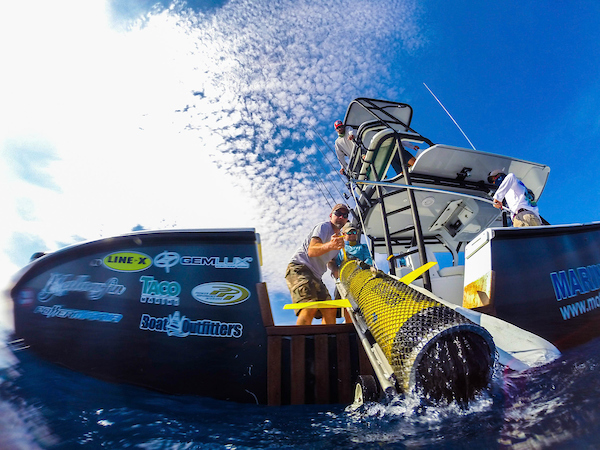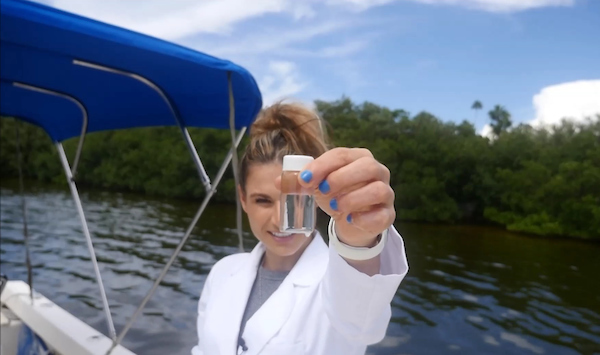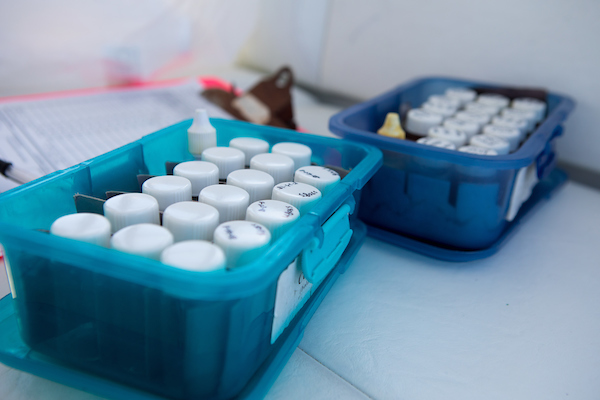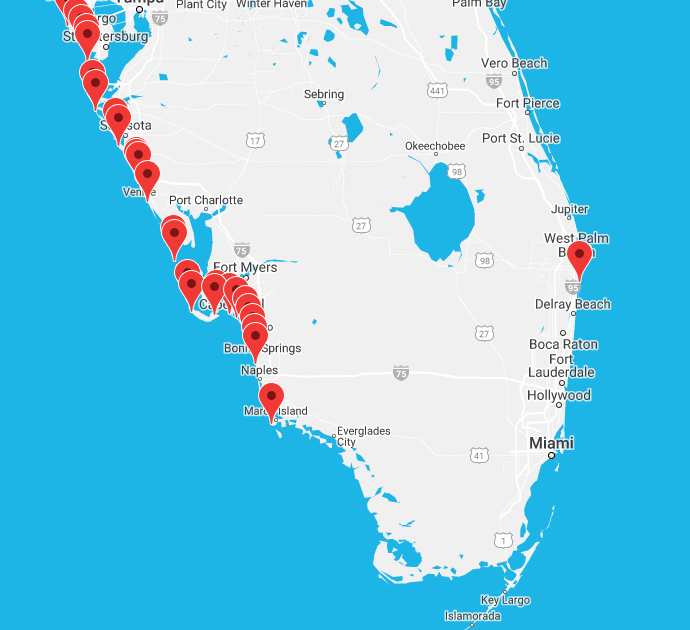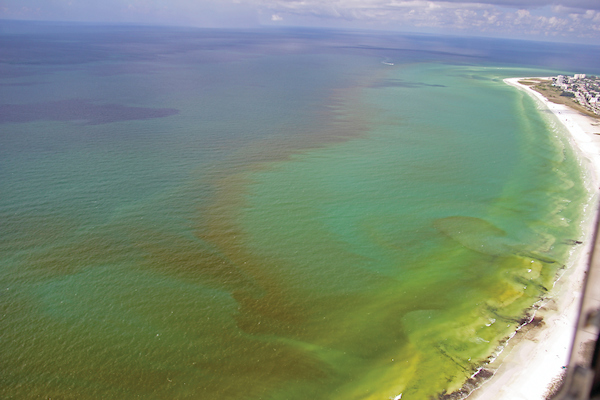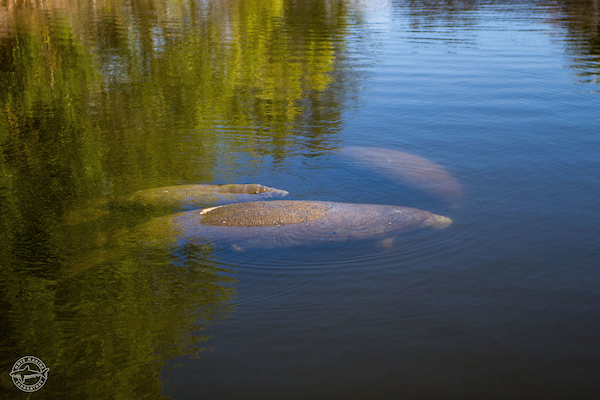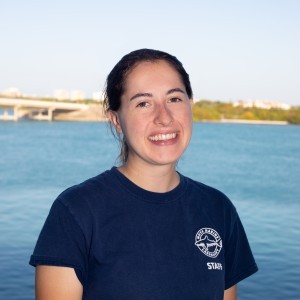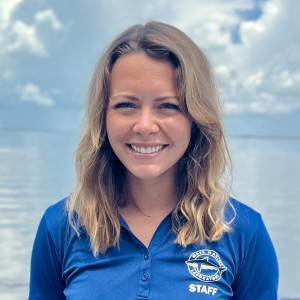Impacts: World-class research at Mote
Battling red tide impacts head on
From late 2017–early 2019, a massive Florida red tide bloom killed nearly 600 sea turtles, more than 200 manatees and 204 dolphins, while severely diminishing communities’ quality of life along west Florida.
During and after the bloom, Mote Marine Laboratory and partners achieved new frontiers in their long-term research to understand and address Florida red tides—elevated concentrations of Karenia brevis algae. New research is building a “toolbox” of potential compounds and technologies to prevent, mitigate and control bloom impacts while doing no further harm to marine ecosystems than blooms are causing.
-
This year, Mote scientists completed a pilot study supported by the Boca Grande community that provided proof of concept that ozone technology could be used to restore a red tide-impacted, dead-end canal. That research built upon prior studies launched by Mote’s Dr. Rich Pierce, other Mote partners and Solutions to Avoid Red Tide (START), testing if Mote’s patented ozone treatment could restore red tide-contaminated seawater back to natural conditions.
After completing these proof-of-concept studies, the stage was set for Mote scientists to progress to study other red tide mitigation products and processes.
-
On Oct. 1, 2018, Mote’s red tide mitigation research team launched a state-funded effort testing several potential mitigation products through a tiered approach from laboratory-scale to larger controlled environments (mesocosms), to field applications.
State funds for this major effort were appropriated by Florida Governor Rick Scott through the Florida Fish and Wildlife Conservation Commission (FWC) to Mote.
In another project, State of Florida funds helped Woods Hole Oceanographic Institution work with Mote and other partners to test a potentially wider-scale mitigation technology: kaolinite clay intended to “grab,” sink, and destroy red tide algae and toxins.
This new clay—different from previously tested clays that were deemed less suitable for Gulf environments—has been quite effective at removing red tide cells and toxins from water in the lab. The next phase is to test the clay in larger experimental systems called mesocosms that mimic aspects of the natural ecosystem. The team has also secured the appropriate government permits to conduct small-scale tests in Gulf Coast waters when the next bloom arrives.
-
In 2018, the Andrew and Judith Economos Charitable Foundation provided the founding donation for the new Red Tide Institute at Mote Marine Laboratory, a dedicated hub of Florida red tide mitigation science. In January 2019, Dr. Cynthia Heil joined as Institute Director with support from the Charles & Margery Barancik Foundation.
In addition to serving as Institute Director, Heil serves as Manager of Mote's Harmful Algal Bloom Mitigation & Ecology Program, applying her decades of laboratory and field experience studying K. brevis and other species of harmful algae, both in Florida and globally. She comes to Mote from Bigelow Laboratory for Ocean Sciences in Maine, where she developed an independent research program focused on water quality, harmful algal blooms and ecosystem management. At Mote, Heil renews her long-term focus on K. brevis research in Florida, where she previously served as Senior Research Scientist & Administrator and Harmful Algal Bloom Group Leader for FWC’s Fish and Wildlife Research Institute and conducted earlier algal bloom research at the University of South Florida’s College of Marine Science.
-
Lab studies by Mote’s Red Tide Institute have identified at least four nontoxic substances that, when applied to the water’s surface, can reduce Florida red tide brevetoxins entering the air—one of them by 95%.
The goal of this research is to reduce a major impact of Florida red tide on communities’ quality of life. Brevetoxins in sea spray cause beachgoers to cough and sneeze while causing more serious symptoms in people with chronic respiratory conditions, sometimes even landing them in emergency rooms. The research is focused on nontoxic compounds with surfactant qualities, such as soaps.
-
Mote’s lab studies this year identified at least six compounds with potential to eliminate Florida red tide algae and its toxins (brevetoxins) from water, qualifying them for further testing.
To find the most promising compounds, Mote researchers considered more than 75 potential compounds in the scientific literature on red tide control and mitigation, weeded out those least suitable for K. brevis and its environment, and tested remaining candidates in lab studies. Most of the scientific literature has focused on killing algal cells, but the more challenging goal is to destroy the toxins they produce—a key focus of Mote’s research.
So far, some of the most promising compounds for fighting K. brevis red tide include specific macroalgae (seaweeds), according to recent research by Heil in Mote’s Red Tide Institute and studies over the past five years by Dr. Vince Lovko and his team in Mote’s Phytoplankton Ecology Program. Testing seaweeds and the compounds they can produce against harmful algae is of interest to Mote scientists because many plants naturally engage in a form of “chemical warfare” called “allelopathy.”
Mote’s Environmental Laboratory for Forensics analyzed some of those macroalgae for polyunsaturated fatty acids that might be responsible for some of the effects that inhibit or kill K. brevis. For two algae analyzed so far, the amount and type of certain polyunsaturated fatty acids seem to correlate with how algicidal the macroalgae are toward K. brevis.
-
In 2019, the State of Florida committed $18 million for a six-year, unprecedented Florida Red Tide Mitigation and Technology Development Initiative (redtidemtdi.org) led by Mote in partnership with the FWC. The Initiative brings together the best and brightest scientists to develop and rigorously test Florida red tide mitigation strategies and related monitoring technologies.
The new Initiative, 379.2273 Florida Statutes, was signed by Governor Ron DeSantis in June 2019 and focuses on the following key goals:
-
Bring together the best and brightest scientists from Florida and around the world.
-
Utilize innovative approaches and technologies to determine the most effective and ecologically sound methods for mitigating adverse impacts from red tide.
-
Test technologies with combinations of lab-based, large-scale mesocosm and pilot-scale field studies ultimately leading to permitting for large-scale field testing and application.
-
Develop novel detection systems to support public red tide forecasting, emergency response, and implementation of control strategies. Enhance public health protection with expansion of Mote’s Beach Conditions Reporting System (visitbeaches.org), local community outreach and engagement.
-
Develop new technologies for smartphone apps to engage citizen science information collaborations and commercial fisherman reporting of red tide toxin concentrations
The Initiative includes six annual opportunities for scientists to submit competitive grant proposals from 2019–2025, and applicants have the opportunity to partner with Mote scientists and utilize Mote facilities, infrastructure and technology.
As fiscal year 2019 concluded, the Initiative was preparing to announce its first competitive grant opportunity at the 10th U.S. Harmful Algal Bloom Symposium and was assembling its Technology Advisory Council, led by Mote President & CEO Dr. Michael P. Crosby with members from Clearwater Marine Aquarium, DEP, FWC, and Florida Atlantic University.
This year Mote hired Kevin Claridge as Administrator for the Florida Red Tide Mitigation and Technology Development Initiative as well as Associate Vice President for Sponsored Research & Coastal Policy Programs. Claridge oversees Mote's Office of Research Grants, Contracts and Sponsored Programs and its Marine Policy Institute. Claridge has almost 20 years of public sector experience directing statewide coastal management, restoration, and resilience programs; managing state lands and conservation easements; administering Air, Waste, Water Facility, and Environmental Resource Regulatory Programs in Southeast Florida; leading large scale mine reclamation efforts in Central Florida; and guiding watershed scale projects associated with Deepwater Horizon and Everglades restoration.
-
-
This year Mote and FWC monitored Florida red tide and conditions that can influence it by collecting 502 water samples between Tampa Bay and San Carlos Bay. Mote completed 1,728 red tide cell counts on water samples collected by the Florida Department of Health in Sarasota County and by Mote scientists on and along Sarasota Bay.
Through their surveys from Tampa Bay to San Carlos Bay, Mote and FWC derived Florida red tide algae cell counts and salinity, temperature, chlorophyll, dissolved oxygen, turbidity, light, and depth data for all samples. They analyzed 358 of the samples for nutrients, toxins and the community of various other microscopic algae that may influence Florida red tide.
Those surveys, and Mote’s red tide cell counts for Sarasota County beaches and Sarasota Bay, support statewide red tide monitoring coordinated by FWC. Overall, the highly productive FWC-Mote cooperative red tide research and monitoring program provides crucial data for understanding and addressing blooms and informing the public about bloom impacts to protect public health.
-
This year, Mote-FWC monitoring efforts added carbonate chemistry sampling that will support a better understanding of Florida red tide dynamics amid climate change, including ocean acidification, driven by excess carbon dioxide.
-
In 2019, Lake Worth Beach became Florida’s first Atlantic-Coast site to join Mote’s Beach Conditions Reporting System (visitbeaches.org)—an online resource developed on Florida’s Gulf Coast that beachgoers can check for red tide impacts and many other conditions.
-
From September 2019–August 2024, Mote is leading a multi-institution study funded by a competitive NOAA ECOHAB grant, investigating why Florida red tide blooms vary in intensity from year to year and ultimately end. Partners are examining the roles of multiple physical, biological and chemical factors in bloom dynamics including termination, the least understood stage.
Prolonged blooms of Florida red tide are ecologically and economically devastating and also cause serious human health impacts. The prolonged bloom of 2017–2019 coincided with extreme weather events including Hurricane Irma, Tropical Storm Gordon and an extremely wet summer, highlighting the need to address the role of extreme events and climate change in magnifying directly or indirectly the intensity and/or duration (i.e. expansion) of blooms, and the environmental factors that ultimately lead to bloom decline.
Scientists in Mote’s Harmful Algal Bloom Mitigation & Ecology Program and partners at Bigelow Laboratory for Ocean Sciences, FWC, New York University-Abu Dhabi, the University of Maryland and the University of South Florida are working collaboratively to address these important questions using new field, laboratory and mathematical modeling approaches.
-
Mote and Florida International University progressed in their second year of a three-year research effort geared towards the ultimate goal of improving veterinary care for red tide-affected manatees. The scientists are investigating whether certain antioxidants can reverse or minimize some effects of red tide toxins on manatee immune-system cells, and are starting to demonstrate positive results in laboratory studies on manatee and human cell lines.
Project scientists have also collected blood samples from approximately 10 red tide rescued manatees and 20 healthy manatees that were not exposed to red tide toxins.
This research is vital because Florida red tide toxins can compromise a manatee’s immune system, causing a harmful phenomenon known as oxidative stress and leaving the animal vulnerable to illness. Manatees can become sick or even die from eating tainted vegetation or inhaling contaminated air.
Photos by: Conor Goulding, Olivia Raney, Mote Marine Laboratory's Manatee Research Program
